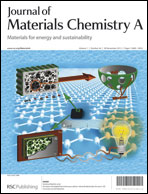Introducing kalium into copper sulfide for the enhancement of thermoelectric properties†
Abstract
Advanced thermoelectric technology offers the potential to convert waste heat into useful electricity, and a mechanism of transmission-free methods for solid state cooling. A low thermal conductivity is a prerequisite for obtaining high efficiency thermoelectric materials. It is a challenge to achieve low thermal conductivity without simultaneously destroying the electric conductivity, for which a ‘phonon glass/liquid–electron crystal’ is proposed. To realize the phonon glass–electron crystal, a host–guest cage crystal system is considered, while to realize the phonon liquid–electron crystal, superionic conductivity is needed. Here we report a novel material, a KCu7−xS4 nanowire, which exhibits enhanced thermoelectric properties compared to the traditional chalcogenide Cu7S4 nanostructure. The presence of K ions not only forms a clathrate and a superionic fluid structure, which provides the phonon glass and liquid–electron crystal, but also adjusts the product to give a nanowire-like morphology. A low thermal conductivity and large Seebeck coefficient can be achieved when the nanowires are pressed into a bulk material. Higher electrical conductivity is also obtained below 420 K. In addition, the numerous grain boundaries, Cu deficiency and the orientated nanowires further increase the thermoelectric properties. The results indicate a new strategy to obtain high efficiency thermoelectric materials by introducing kalium into copper chalcogenides to form a new crystal structure with ‘phonon glass and liquid–electron crystal’ properties.


 Please wait while we load your content...
Please wait while we load your content...